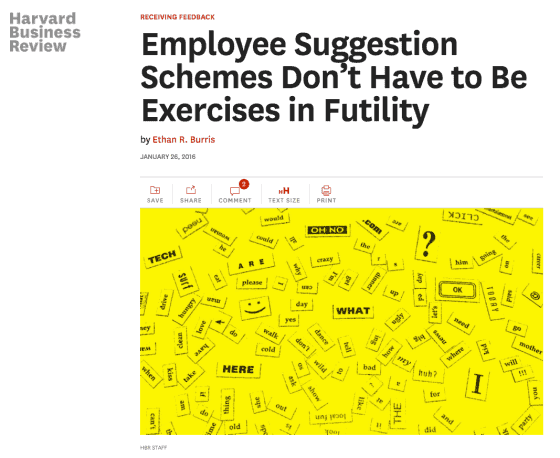At KaiNexus, we've been fortunate to have a good relationship with Professor Ethan Burris, from the University of Texas McCombs School of Business. He has done a lot of research and publishing around employee engagement and idea systems, as I've mentioned here on the blog before:
“Is Fear the Only Reason Employees Don't Speak Up?“
Burris has a new article on the Harvard Business Review website:
“Employee Suggestion Schemes Don't Have to Be Exercises in Futility“

In my own work and travels, it's hard to find anybody who has good things to say about suggestion boxes and typical suggestion box systems. See my past posts about this. As Joe Swartz and I point out in our book Healthcare Kaizen, suggestion boxes and a healthy Kaizen process are very different. Kaizen can be much more effective because of the practices, mindsets, and leadership behaviors involved. Tear down the suggestion box… and start a Kaizen process instead.
Many organizations, in the private sector and government, have tried electronic or digital suggestion boxes… with all of the same success that you'd see with paper boxes. See this Washington Post article: “The (86,000) budget-cutting ideas that got away.” One way that a Kaizen system is different than suggestion boxes is that effective Kaizen systems ask employees for far more than cost reduction.
In the HBR article, Burris says:
“Here's the irony of moving up in most organizations:
You have more power to make changes but less visibility into what should change.
Because you are no longer on the front lines directly encountering many of the organization's most pressing needs, you must rely on lower-level employees to share their observations and ideas.
But gathering insights from hundreds, or thousands, of employees can be a daunting process. No one has time to sit down with everybody individually, or even in groups.”
It's incredibly important to involve front-line employees in identifying and SOLVING problems. You can't have everything flow up to a single committee or executive team. Maybe we should challenge the idea that we don't have time to work with everybody… and MAKE time, instead.
President Bill Clinton sort of made a similar remark about getting input from everybody when I saw him speak Saturday at a Patient Safety Movement event in California). I'm possibly paraphrasing, but Clinton said:
“Give people time to find small things that, put together, will make a big difference. A coalition of diverse perspectives to solve a problem like hospital infections…”
There's no single magic silver bullet that solves hospital-acquired infections… so we need lots of people identifying as many possible causes and countermeasures as possible.
Listen to Mark read the post (subscribe to the “Lean Blog Audio” podcast):
Burris writes about the dysfunctions of suggestion box systems (even in the digital realm):
- Having a system available doesn't mean people will use it
- Organizations focus too much on collecting ideas and not enough on evaluating them
- “… electronic suggestion boxes breed a sense of futility, much like their older-school physical counterparts collecting dust in the corners of offices.” (too few ideas are actually implemented)
I agree with Burris that leaders need to engage employees — in person and offline, not just online. We need to tell them what goals are important. We need to explain what sorts of ideas are wanted (I'd emphasize small ideas that create a better workplace and better serve patients… not just cost reduction).
Burris points out something we've held to at KaiNexus for a long time… that we're different than an electronic suggestion box system. Instead of people across a company voting on ideas that aren't relevant to them, we encourage people to test and evaluate ideas within their local workgroup when they can. That's a more Kaizen-y approach… seeing problems and solving problems rather than escalating everything.
Burris writes:
“Other suggestion platforms take a different approach altogether: Instead of casting an ultrawide net to scoop up the few “big” ideas, they aim to implement a larger percentage of incremental ideas.
For instance, I am currently conducting research with a small software company in Austin, KaiNexus, which draws on the continuous improvement and lean manufacturing philosophies to help clients implement upwards of 75% of the ideas they collect within local teams and departments. The idea is to gain momentum and build a culture of improvement by tackling smaller ideas more routinely.
This approach seems promising because futility may be the largest psychological roadblock to soliciting feedback digitally. If the chance of implementation seems trivial, people just won't bother to contribute ideas — or they'll throw in safe, token suggestions and call it a day. And neither of those outcomes gets you any closer to creating a culture of innovation or creativity, which is really the point of any suggestion box, whether it's digital or not.”
Suggestion boxes breed futility because you normally only get 2 to 3% of ideas being selected for implementation. See my webinar on “The Suggestion Box is Dead.”

We don't want futility. KaiNexus won't be successful if we acquire customers who then don't make good use of the software… because they're not soliciting and implementing enough ideas. Success requires leadership, methodology, and technology.
Don't get trapped by the promise of suggestion boxes – paper or electronic. There's just too much evidence that they don't work. Yet, people STILL start suggestion box systems, even here in 2016.
You don't have to use software… that “technology” could perhaps be cards and bulletin boards to start… but make sure you're following a Kaizen-based approach instead of a suggestion box system.
Please scroll down (or click) to post a comment. Connect with me on LinkedIn.
Let’s build a culture of continuous improvement and psychological safety—together. If you're a leader aiming for lasting change (not just more projects), I help organizations:
- Engage people at all levels in sustainable improvement
- Shift from fear of mistakes to learning from them
- Apply Lean thinking in practical, people-centered ways
Interested in coaching or a keynote talk? Let’s talk.
Join me for a Lean Healthcare Accelerator Trip to Japan! Learn More










By letting people (the process owners) to elect some one from them to review the ideas in periodic intervals will make them trust the system and believe it’s vital.
Or by making it on a visual board, so everybody can see the ideas daily could be more effective in engaging people, as they will think that leadership trust them and appreciate their capability in improving there workplace.
Thanks a lot Mark for sharing such great topics.
Comments are closed.